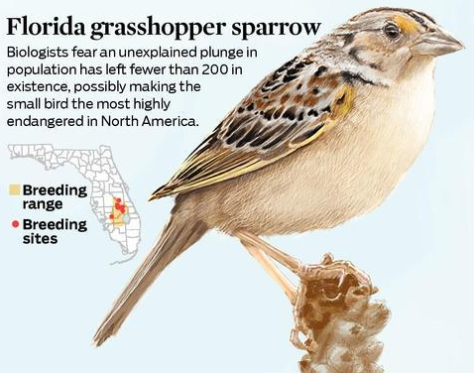Among the most endangered birds in North America is the Florida grasshopper sparrow (Ammodramus savannarum floridanus). The prairie is home to the last wild population of the Florida grasshopper sparrow. Fewer than 150 are believed to remain of the tiny sparrow, which is found only on the prairie of central Florida. The Florida grasshopper sparrow would be the first confirmed bird extinction in the continental United States since the Dusky seaside sparrow, also found in Florida, died out in 1987. The Florida grasshopper sparrow is considered a flagship species representative of the central Florida prairie, a habitat that even few Floridians have seen. “This might be the last gasp genetically to save the Florida grasshopper sparrow,” says Paul Reillo of the Rare Species Conservatory Foundation’s captive breeding center outside of West Palm Beach. He points toward a row of cages where fledglings perch on slender branches. Recordings of wild Florida grasshopper sparrows help them learn to sing. The fledglings are among 21 Florida grasshopper sparrows housed here in shipping containers in the shade of cypress and palm trees. Reillo says they were rescued from failing or flooded nests on the prairie after years of deliberation among researchers and government agencies over whether taking sparrows for captive breeding might negatively impact their wild population.
“Captive breeding I think is universally recognized in the conservation community as one of the last intervention efforts that you undertake. We want to keep species in the wild. We want endangered species to recover in the wild.” The debate was settled last year when a mother was found dead outside of a nest of chicks. Then this spring a series of heavy rains inundated the prairie, leaving eggs floating and threatening to wipe out a generation of the critically endangered sparrow.
Reillo and his staff raised the orphaned chicks and incubated the eggs, feeding the hatchlings on an exhausting schedule of every 40 minutes for nearly 24 hours a day. “We started with a rather motley misfit group of founders, and yet we saw amazing reproductive effort. That’s a hopeful sign.”
The goal is to re-introduce the captive-bred Florida grasshopper sparrows back to the wild, but Reillo says that still is at least a few years away. “The next step in my opinion is can we produce in captivity a fully parent-reared offspring. Fully parent-reared. That means both parents contributing to the care and nurturing of the chicks all the way through to independence.”
Florida grasshopper sparrows are omnivores, with most of their diet consisting of insects, such as grasshoppers, crickets, beetles, and moths. Most of the vegetation in the sparrow's diet is made up of sedge seeds and star grass seeds. Florida grasshopper sparrows forage near the ground, and thus, frequent fires are essential to maintain areas of bare ground for foraging.
Sources: WMFE, 25 October 2016
http://www.wmfe.org/an-urgent-effort-to-rescue-a-tiny-sparrow-from-exti…
Wikipedia
https://en.wikipedia.org/wiki/Florida_grasshopper_sparrow

- Login om te reageren
